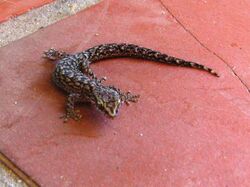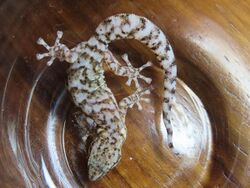Biology:Marbled leaf-toed gecko
| Marbled leaf-toed gecko | |
|---|---|

| |
| Scientific classification | |
| Domain: | Eukaryota |
| Kingdom: | Animalia |
| Phylum: | Chordata |
| Class: | Reptilia |
| Order: | Squamata |
| Family: | Gekkonidae |
| Genus: | Afrogecko Bauer, Good, & Branch, 1997 |
| Species: | A. porphyreus
|
| Binomial name | |
| Afrogecko porphyreus (Daudin, 1802)
| |
| Synonyms | |
|
Gecko porphyreus Daudin, 1802 Phyllodactylus porphyreus (Daudin, 1802) | |
The marbled leaf-toed gecko[2] (Afrogecko porphyreus) is a gecko found in southern and southwestern South Africa (including many offshore islands) and in Namibia.[3] It is a flat, medium-sized gecko.
Description
Afrogecko porphyreus has a mottled, greyish body, a long tail and sometimes a pale stripe along its back. However, its coloration varies from almost black-and-buff patterning, to smudged shades of buff. It is an adaptable little forager, hiding under debris, beneath bark, among rocks and even in city houses.
These geckos eat large numbers of small insects, so a population of them living on one's property serves as a natural form of pest-control. Their diet is an array of invertebrates, including feeder insects. However, domestic cats commonly kill large numbers of these little lizards, sometimes exterminating them in a local area. They also are preyed upon by species of spiders in the genus Palystes, that may be more effective gecko predators than cats are.
As in many similar gecko species, one of their major defences is autotomy of their tails, and in some populations, nearly all mature specimens have tails either regenerated, or in the process of regeneration.
Distribution
This gecko occurs commonly in the southern parts of South Africa , from Cape Town (where it now inhabits suburban gardens) eastwards as far as the Eastern Cape.
A. porphyreus are not aggressive or territorial, and several of them will often live together in a single retreat. These sociable lizards will even share nests, where several females will lay their eggs.
References
- ↑ Bates, M.F.; Branch, W.R. (2018). "Afrogecko porphyreus". IUCN Red List of Threatened Species 2018: e.T169704A115655679. doi:10.2305/IUCN.UK.2018-2.RLTS.T169704A115655679.en. https://www.iucnredlist.org/species/169704/115655679. Retrieved 18 November 2021.
- ↑ "Afrogecko porphyreus (Marbled leaf-toed gecko)". Biodiversity Explorer. http://www.biodiversityexplorer.org/reptiles/squamata/gekkonidae/afrogecko_porphyreus.htm.
- ↑ Afrogecko porphyreus at the Reptarium.cz Reptile Database. Accessed 23 August 2016.
Wikidata ☰ Q2709836 entry
 |




